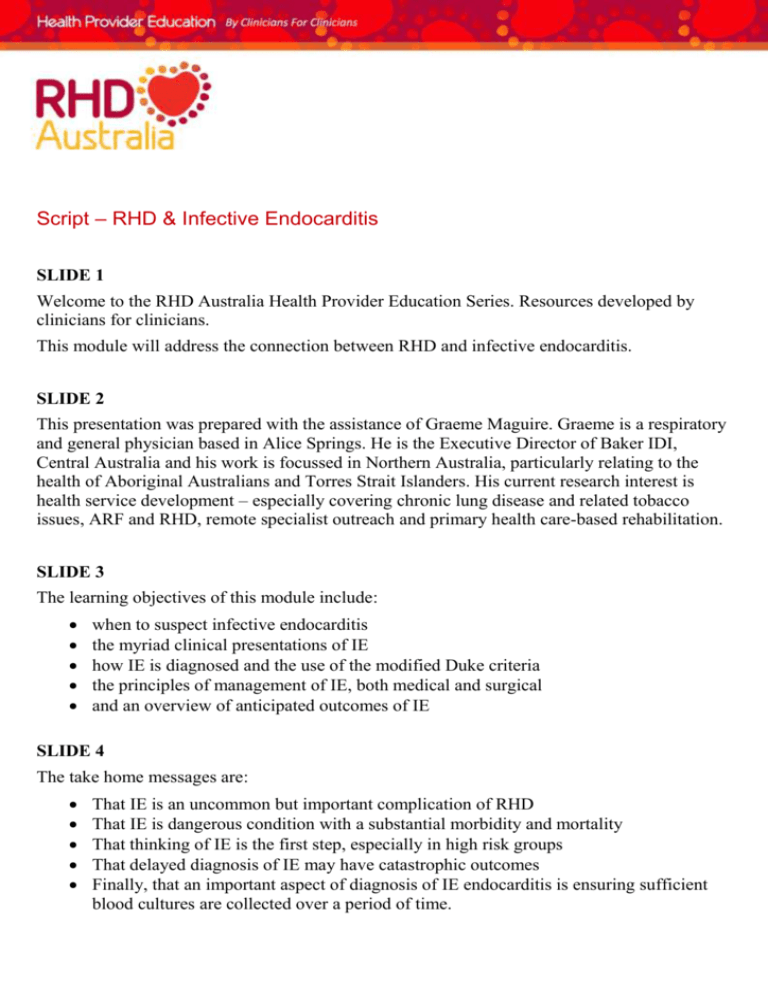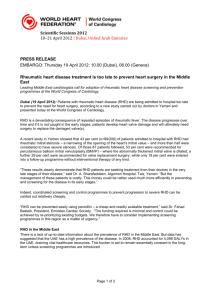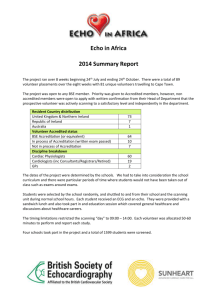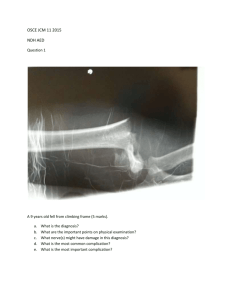Script (DOC) - RHD Australia
advertisement

Script – RHD & Infective Endocarditis SLIDE 1 Welcome to the RHD Australia Health Provider Education Series. Resources developed by clinicians for clinicians. This module will address the connection between RHD and infective endocarditis. SLIDE 2 This presentation was prepared with the assistance of Graeme Maguire. Graeme is a respiratory and general physician based in Alice Springs. He is the Executive Director of Baker IDI, Central Australia and his work is focussed in Northern Australia, particularly relating to the health of Aboriginal Australians and Torres Strait Islanders. His current research interest is health service development – especially covering chronic lung disease and related tobacco issues, ARF and RHD, remote specialist outreach and primary health care-based rehabilitation. SLIDE 3 The learning objectives of this module include: when to suspect infective endocarditis the myriad clinical presentations of IE how IE is diagnosed and the use of the modified Duke criteria the principles of management of IE, both medical and surgical and an overview of anticipated outcomes of IE SLIDE 4 The take home messages are: That IE is an uncommon but important complication of RHD That IE is dangerous condition with a substantial morbidity and mortality That thinking of IE is the first step, especially in high risk groups That delayed diagnosis of IE may have catastrophic outcomes Finally, that an important aspect of diagnosis of IE endocarditis is ensuring sufficient blood cultures are collected over a period of time. SLIDE 5 More information regarding the management and prevention of IE can be found in the Australian Guidelines for the Prevention Diagnosis and Management of ARF and RHD. These have been substantially reviewed, revised and expanded, and can be found on the RHD Australia website. SLIDE 6 A Quick Reference Guide is also available which can be an invaluable resource for busy clinicians. SLIDE 7 Further information regarding other aspects of the prevention diagnosis and management of ARF and RHD for health providers can be found at the RHD Australia Health Provider Education portal. SLIDE 8 Before proceeding further we should define the abbreviations used in this presentation. The first is ECHO or echocardiogram. This is a key investigation for the diagnosis of both RHD and IE Infective endocarditis, also known as IE, is a microbial infection of one or more of the heart valves Our native heart valves (or NHVs) are our own the heart valves we’re born with, as distinct from prosthetic heart valves (or PHVs) that have been surgically inserted Thus when talking about IE, we use the terms native valve endocarditis (or NVE) and prosthetic valve endocarditis (or PVE) Rheumatic heart disease (or RHD) the chronic autoimmune disease of heart valves, originally triggered and subsequently driven by infection with Group A streptococcus There are two types of echocardiograms commonly used in clinical practice. The best known is transthoracic echocardiography (or TTE), when the ultrasound probe is placed on the outside of the chest wall, neck and upper abdomen. On the other hand, for a trans-oesophageal echocardiogram (or TOE) the ultrasound probe is passed down the oesophagus or gullet. A TOE provides better views of the left atrium, mitral valve and aortic valve….and is particularly useful for diagnosing IE and assessing the damage it has done. A TOE can only be done in hospital. SLIDE 9 So, what is infective endocarditis? IE is a microbial infection of the endocardium, or inside lining of the heart. More importantly, IE almost always occurs on one or more heart valves where it causes an infected blood clot to form. This is called a vegetation. IE is more likely to occur on previously damaged heart valves - such as those damaged by RHD or a previous episode of IE - or on congenital valve abnormalities. It is also more likely when there is foreign material in the heart, such as a PHV or a patch used to close a congenital heart defect or a pacing lead. IE is also more common in people who have recurrent bacteraemia. These people include injecting drug users, people with long-standing intravascular access for whatever reason and people on haemodialysis. SLIDE 10 IE comes with many potential complications. First there is direct damage to the infected heart valves. This often causes valve leaking or regurgitation with abnormal backwards flow through the valve and increased volume loading on the heart pump. Volume overloading can lead to heart failure Infection can extend to the deeper structures of the heart, including the conducting system, causing rhythm problems - including complete heart block or AF IE can also present with the clinical picture of uncontrolled infection and sepsis, depending on the virulence of the infecting microorganism. Typically, it’s the valvular vegetation that harbours the offending pathogen. Once a vegetation forms, the microbes hide out in this privileged site, relatively sheltered from the body’s antimicrobial defences. The vegetation then becomes the source of persistent bacteraemia. Of course, if parts of a vegetation break off, infected emboli are released into the arterial tree causing arterial occlusion - and possibly distant seeding of infection. The most dramatic and tragic embolic event is a stroke. IE can also lead to immune-mediated inflammation of the kidneys, sometimes with impairment of kidney function. Importantly, untreated IE is universally fatal. Even with treatment, up to 30% of people with IE still die. SLIDE 11 So let’s look further at the relationship between IE and RHD. As previously mentioned, there is an increased risk of IE in people with RHD who, by definition, have damaged heart valves. Microbes are more likely to adhere to distorted and thickened valves and infection take hold. Indeed, one study conducted in the North of Australia showed that the risk of IE was 58 times greater in someone who had RHD than in the general population. Of course IE greatly increases the complications and deaths related to RHD. Globally, the burden is huge. It has been calculated that, worldwide, there are more than 34,000 cases of RHD-related IE each year, leading to 8,000 deaths and contributing to over 100,000 strokes. RHD-related IE is not commonly seen in Australian urban, suburban and even regional medical practice. However, at a global level, RHD is a major driver of IE and, as such, is a major contributor to the misery, in the form of morbidly and mortality, of RHD. Remember that RHD is a preventable disease. SLIDE 12 This shows a graphic depiction of IE of the mitral valve. On the left we can see a mitral valve leaflet with two irregular nodules adherent to the margins of the mitral valve with the cordae tendineae seen extending inferiorly. These nodules are vegetations, consisting of a combination of clotted blood and fibrin. These vegetations are an ideal place for microbes to hide and multiply, relatively protected from the body’s antimicrobial defences. On the right is a standard TTE view of the LV, with the MV inferiorly and AV superiorly. Here you can see a small nodule fluttering on the upper or anterior MV leaflet. This is likely to be a MV vegetation and is a classic feature of IE seen with a TTE. SLIDE 13 So let’s examine again who is at risk of IE. People with RHD People with a PHV or any intracardiac foreign material in place People with congenital heart disease or other valve abnormality People with a previous episode of IE People with recurrent bacteraemia - including injecting drug users, people with longterm intravascular devices and people having haemodialysis However, it should be remembered that at least a third of people with IE have no identified risk factors. So, the diagnosis of IE should be considered in anyone with a stroke. or with features of sepsis, especially if a cause not immediately obvious. SLIDE 14 So let’s look at presents of IE. The key message here is that IE is the great mimicker. Sometimes the symptoms are not particularly severe, IE can grumble on for a long period of time with non-specific clinical features. Often the hardest part of the diagnosis is thinking of it. Fever is common, sometimes low grade fever, with evening chills and sweats in the early hours of the morning. Malaise is also common, this is a feeling of being generally unwell, possibly with loss of appetite and weight loss. It’s important to consider IE in someone with unexplained haematuria. The haematuria is often microscopic, so the urine can appear normal but the urine dipstick will be positive for blood. Fatigue and shortness of breath may due to heart failure or heart rhythm problems. Fatigue and shortness of breath can also be caused by anaemia - anaemia from haemolysis across an abnormal heart valve or anaemia of chronic disease. It is important to consider IE in someone who present with a stroke, especially someone with a predisposing factor for IE, such as RHD. SLIDE 15 There’s a wide range of clinical signs of IE; these can be generally divided into immunologic manifestations and vascular manifestations, with some overlap. Immunologic manifestations are driven by the immune response to ongoing infection and inflammation. They include: Glomerulonephritis – with micro or macrohaematuria The tender red nodules on the fingertips called Osler’s nodes Inflammatory patches on the retina known as Roth’s spots The classic sign of digital clubbing of fingers and toes with increased curvature of the nails, loss of the nail angle and swelling of the terminal phalanx SLIDE 16 The vascular manifestations are due micro-embolization or macro-embolization from valvular vegetations. The most dramatic complication is a stroke. There are several possible mechanisms. Of course, an embolus occluding a major arterial branch will result in an obvious and dramatic ischemic stroke. However smaller emboli may cause less-obvious neurological deficits that may take time to be recognised. In addition, a micro-embolus can sometimes infect a blood vessel wall in the brain, or anywhere. The wall weakens at that spot and bulges out into an aneurysm, a socalled mycotic aneurysm, which can rupture and cause devastating haemorrhagic stroke. Septic emboli can also travel to solid organs causing local infarcts. Likely organs include the kidney, spleen, liver and gut. IE in the R side of the heart often sends infected emboli to the lung. Micro-emboli can travel to the small vessels in the periphery and cause digital infarcts and small infarcts seen under the nails called splinter haemorrhages. SLIDE 17 This is an echocardiogram of IE. It shows the mobile nature of the vegetation on the MV leaflet highlighted by the red arrow. SLIDE 18 This can cause damage to the heart valve, with leaking or regurgitation. This is shown here in the coloured Doppler image. There is a small jet of central mitral regurgitation. SLIDE 19 So we have looked at the myriad clinical features of IE and seen that many of these can be nonspecific. So how best to make the diagnosis? This is where the Duke criteria can be of great assistance. They are listed here. The Duke criteria provide a simple scoring system that helps clinicians determine the likelihood that someone has IE. It also provides a valuable diagnostic guide for clinicians, pointing to the most appropriate tests to substantiate a diagnosis of IE. First up, note that a definitive diagnosis can only be made after microbiological and histological examination of infected cardiac material. Of course, this requirement is not really practical in most people, unless the diagnosis is made in retrospect following valve surgery or at a postmortem examination. So that leaves us with making a clinical diagnosis, rather than a pathological diagnosis, in most people with IE. This is where we need well-defined clinical criteria. The Duke criteria divide clinical features into ‘major’ and ‘minor’. To make a diagnosis of IE we require: two major criteria one major and three minor or five minor criteria Sometimes we suspect IE but can’t meet all the required criteria. That’s why there’s also a group called ‘possible IE’. Here, fewer criteria are met but, in the absence of a reasonable alternative, the likelihood of IE remains high. Criteria are also provided to help us reject a diagnosis of IE. These include a firm alternate diagnosis that explains the evidence at hand. Additionally, complete resolution of symptoms with only a short course of antibiotics reasonably excludes IE as a cause. If someone goes to surgery and no pathologic evidence of IE is found, especially if they’ve had no antibiotics or a very short course, IE is again rejected as a diagnosis. SLIDE 20 So what are the most common clinical criteria for making a diagnosis of IE? As the table shows, there are major and minor criteria. A diagnosis of IE can be made if there are 2 major criteria, one major and three minor or five minor criteria. The major criteria include: Finding a typical organism on blood culture Echocardiographic indications of a vegetation or abscess A new heart murmur Evidence of Q fever infection due to Coxiella burnetii. Australian clinicians, especially those working in rural and remote settings, will be aware that Q fever is well-known cause of IE in this part of the world. Minor criteria include: Coming from a high risk group; including pre-existing valvular heart disease (such as RHD and congenital HD) or history of injecting drug use A sustained fever higher than 38ºC Vascular phenomena; including arterial emboli, infarcts, haemorrhagic strokes or aneurysms in the brain Immunologic phenomena; including glomerulonephritis, Osler’s nodes, Roth’s spots and a positive blood test for RhF Other minor criteria include having insufficient conclusive blood cultures, and suspicious but non-diagnostic echocardiographic findings SLIDE 21 As mentioned, a key diagnostic factor is recovering typical micro-organisms from blood cultures, and sufficient numbers of blood cultures. This is critical. Ideally we require at least two positive blood cultures drawn more than 12hrs apart. This can be done in most people, especially when their symptoms suggest a subacute infection. Of course, when someone is really sick we can’t wait that long. For people who are unwell and require treatment before the 12 hour period, it is still possible to meet the major criteria based on blood cultures taken over a shorter period. That is at least 3, and preferably more, blood cultures taken over an hour or more. SLIDE 22 The typical causative micro-organisms for IE are listed here. They include the group of bacteria called the ‘viridans streptococci’. Also Streptococcus bovis, Staphylococcus aureus and community-acquired enterococci in the absence of a primary focus such as an intravascular device. Then there’s the so-called HACEK group that includes several Haemophilus species, Actinobacillus actinomycetemcommitans , Cardiobacterium hominis, Eikenella corrodens and Kingella kingeae. These are difficult to remember. Always look them up. SLIDE 23 Another classic organism is shown here. Coxiella burnetii, the cause of Q fever, is named after an Australian Nobel Prize-winning researcher, Frank Macfarlane Burnet. It is often difficult to diagnose Q fever because is it so hard to culture in the laboratory. And Q fever serology is not always straight forward even for highly experienced infectious diseases clinicians. Of course, it is more helpful if the PCR for Coxiella burnetii is positive in blood. Blood cultures alone will not determine a diagnosis of IE; we need more evidence. SLIDE 24 The best evidence comes from echocardiography. As we’ve noted, there is TTE, the standard investigation with the probe on the chest wall, or TOE with the probe in oesophagus. A TOE requires a light anaesthetic. A TTE is usually done first up. If TTE is unhelpful but the clinical features still suggest IE, then TOE is the next move. If there’s a PHV in place it is best to go straight to TOE because TOE provides better quality images of PHVs. It should be remembered that a negative TTE, and even a negative TOE does not exclude a diagnosis of IE. However, if the clinical suspicion of IE is low and there are no diagnostic echocardiographic findings, it is wise to seek alternative diagnoses for the presenting clinical symptoms. SLIDE 25 What are the typical features of IE on echocardiography? The standard diagnostic features are: An oscillating intracardiac mass indicating a vegetation An abscess or collection of pus particularly in the myocardium New damage to a PHV To summarise, the diagnosis of IE is best made with the help of the modified Duke criteria. The first step is to think of IE as a possible diagnosis. The next step is to consult the criteria without delay. Potential complications of IE can be unpredictable and devastating. SLIDE 26 A key aspect of management of IE is careful clinical follow-up. That includes assessment of response to therapy, clinically and with serial echocardiography. IE still has a high morbidity and mortality, even in the modern era. The course is often unpredictable; events can quickly spiral out of control. Thus, if IE is suspected, we recommend early referral to a medical centre with experienced specialists and appropriate facilities. Despite the best medical treatment, some people develop complications requiring surgical intervention. A multi-disciplinary approach has been shown to produce the best outcomes. Thus, early surgical referral strongly advised. Immediate surgical referral is essential for people with PVE, perivalvular abscesses, large vegetations or heart failure due to valve destruction. SLIDE 27 One potentially devastating complication of IE is stroke; ischemic stroke or haemorrhagic stroke. The key to preventing embolic stroke in IE is starting antibiotic treatment as soon as possible. The risk of stroke is highest in the first week of treatment and then it drops away. This reinforces the importance of first suspecting IE then getting on with the job of confirming the diagnosis and commencing treatment. We know that people who are anti-coagulated are at higher risk of intracerebral haemorrhage. This includes people with PHVs, particularly mechanical heart valves. However, in the setting of IE it is important to continue the anticoagulation medication unless there are absolute contraindications. There’s no clear rationale for commencing anticoagulation to prevention of ischemic stroke in people with NVE. SLIDE 28 More information regarding the management of stroke both in RHD and IE can be found in the Prevention and Management of Complications section of the RHD Australia Health Provider Education modules. SLIDE 29 The other key aspect of medical management of IE is antimicrobial therapy. It’s important that antimicrobials are commenced ONLY after adequate numbers of blood cultures have been taken. We’ve already highlighted, ideally there should be at least 12hours between the 1st and the last blood culture. However, when someone is acutely unwell and needs urgent treatment, 3 or more pre-treatment blood cultures can be collected from different sites, over at least 1hour. Once a clinical diagnosis of IE has been made, and whilst awaiting the results of blood cultures, empiric antimicrobial therapy should cover the most likely pathogens. They have been listed on a previous slide. SLIDE 30 IE requires prolonged antimicrobial therapy. This is because there are often high bacterial concentrations within vegetations, a site where there is little assistance available from the host’s antibacterial defences. Some of the microbial population is also in an almost switched-off metabolic state at any one time. Some antibiotics, such as beta-lactams, only kill multiplying organisms. So, a long antimicrobial ‘soak’ is needed. Interruption to a treatment course will usually precipitate recurrence of the IE. SLIDE 31 The management and choice of antibiotics in IE is complicated. This is one of the reasons why early specialist input is so important. Further information regarding the latest recommendations for antibiotic choice, dosing and length of therapy can be found in the Therapeutic Guidelines: Antibiotic (version 14) available on the internet. PAGE 32 Once you’ve made a diagnosis of IE, and appropriate therapy started the next consideration is about possible surgery. Guidance regarding this has been provided by the American College of Cardiology and the American Heart Association in their Guidelines for the Management of Patients with Valvular Heart Disease. Call your local cardiothoracic surgeon anyway. Don’t delay. SLIDE 33 This table depicts the recommendations for NVE. You can see that specific recommendations are divided into Class I, 2A and 2B. SLIDE 34 In the case of PVE the recommendations are listed here. You can see that not all patients with PVE need surgery or require a valve replacement. Nonetheless, there is a substantial risk of relapse. The Class 3 recommendation says that uncomplicated IE caused by a first infection with a sensitive organism affecting a PHV is not in itself, an indication for surgical intervention. SLIDE 35 Despite this, PVE is difficult to manage and outcomes can sometimes be poor. Between 10 and 30% of people with PVE who undergo surgery will die. Without surgery the most will die. It is difficult advocating for surgery in people with such high operative mortality and, even if people, survive their surgery, the risk of recurrence can be to 6 to 15 percent. SLIDE 36 There is no evidence that delaying surgery improves outcome. It is clear that when there is deep seated infection or when there is moderate to severe heart failure, the benefits of surgery far outweigh the risks. SLIDE 37 The complications of PVE are equivalent to NVE. More than half the people with IE will develop some complication from their infection. These complications are related to the size of vegetations - the bigger the vegetation, the greater the risk. People with small vegetations, less than 6mm, having a 1 in 10 chance of complications compared to people with large vegetations of 16mm or more, who have a complication rate of 100%. SLIDE 38 What are the complications of IE? Many are cardiac and occur in up to half of people with IE cases. Embolic complications occur in 13 -40% of people. More than one in three cases will have a neurologic or renal complication. We shouldn’t forget metastatic abscesses, including those in bone such as vertebral osteomyelitis. Complications can also be caused by the treatment: iatrogenic complications. These can include drug fevers and problems with vascular access. SLIDE 39 The poor outcomes for IE emphasise the importance of early diagnosis, antimicrobial therapy and specialist led management. The mortality of IE is still high. People with Staphylococcus aureus endocarditis are at particular risk. SLIDE 40 So, what does this mean from an Australian perspective, particularly for people with RHD? A team of researchers in the north of Australia recently undertook an audit of IE in FNQ and Top End of the Northern Territory. Much of what was found reflects that seen in other developed world settings and populations with low rates of RHD. SLIDE 41 This study confirmed the risk factors for IE as RHD, congenital heart disease, prosthetic heart valves or cardiac prosthetic material, previous IE and injecting drug use. Thus, even in a remote northern Australian setting, the same risk factors hold true. Two thirds of people had identified risk factors and one third did not fall into any classic risk group. SLIDE 42 There were numerous likely triggering events, but the most common was recent intravascular access. This included people on dialysis and people with long term intravascular catheters, such as central lines and Portacaths. A high index of suspicion for IE should be maintained in these groups. SLIDE 43 Staphylococcus aureus, including MRSA, accounted for more than 40% of the isolates, reinforcing that it is key pathogen and must be covered when commencing empiric therapy for suspected IE. This is true even in people who have no recent healthcare facility exposure. Community acquired methicillin-resistant Staphylococcus aureus is of particular concern. Streptococci and enterococci were the other common organisms. SLIDE 44 Alas, outcomes were much the same as elsewhere. 1 in 5 patients died and 1 in 5 patients required heart valve replacement or other surgery. This reinforces the importance of early referral to an experienced specialist-led team. SLIDE 45 So what about preventing IE? In Australia, prophylactic antibiotics are recommended for people at high risk of IE undergoing procedures associated with transient bacteraemia. This includes people with PHV, previous IE, congenital heart disease, cardiac transplantation and RHD in Aboriginal Australians. Recent recommendations now extend to RHD in anyone – whether or not they are Indigenous Australians. Details regarding these recommendations can be found in the National Acute Rheumatic Fever and Rheumatic Heart Disease Guidelines on the RHD Australia website and the Therapeutic Guidelines: Antibiotic (Version14). SLIDE 46 Despite these recommendations, there is controversy about the effectiveness of such prophylaxis, and good evidence is scant. Despite this lack of evidence, prophylactic antibiotics are still advised in the specific circumstances outlined. SLIDE 47 The recommendations for antimicrobial prophylaxis for IE are listed here. In those people who have been taking long-term penicillin or other beta-lactam antibiotics for more than a month, as occurs with secondary antibiotic prophylaxis for ARF or RHD, then a non-beta-lactam antibiotic such as clindamycin can be given orally. There are also IV alternatives listed In those people not on penicillin, and who aren’t hypersensitive to penicillin, then amoxicillin either orally, intravenously or intra muscularly is recommended. They key thing is to refer to the Guidelines. SLIDE 48 The list of procedures requiring prophylaxis is listed here. If you would like to learn more, particularly about the role of dental care and antibiotic prophylaxis, there is a separate module in the RHD Australia Health Provider Education series. SLIDE 49 In conclusion, IE is an uncommon complication of RHD. Yet, it has significant consequences with more than half of the people developing complications, 1⁄5 dying and 1⁄5 requiring surgery. So it’s important to suspect it and act early if you think the diagnosis is possible. As highlighted, it’s especially important to think of IE in the high risk groups. Once you think of it act. Take multiple blood cultures before starting antimicrobial treatment. In any patient presenting with stroke, especially someone with a history of RHD, immediately think of IE. SLIDE 50 If you would like to know more about ARF and RHD please refer to the new Australian guidelines. Further education modules are available at the RHD Australia Health Provider Education website. SLIDE 51 You can also register at the Health Provider Education website for additional resources, There you can download this and other PowerPoint presentations for your use in your own practice plus the additional assessment items for training providers. If you would like to be notified about new modules and updates, please ‘Like’ us on Facebook at the address provided below. SLIDE 52 And finally, for those of you who would like to test your knowledge regarding the information presented in this module please go to the brief self-assessment quiz at the link provided on this website.






